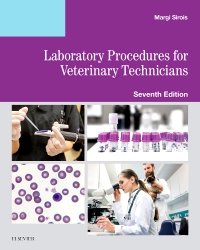
Laboratory Procedures for Veterinary Technicians Elsevier eBook on VitalSource, 7th Edition
Elsevier eBook on VitalSource

Ensure your Vet Tech students are at their clinical best! Laboratory Procedures for Veterinary Technicians, 7th Edition covers the broad spectrum of laboratory procedures that veterinary technicians need to perform effectively in the practice setting. Comprehensive content presents the fundamentals of microbiology, hematology, urinalysis, immunology, and cytology, along with the laboratory procedures used to perform the most widely used tests such as complete blood count, urinalysis, and immunologic assays. This thoroughly updated edition includes an expanded Quality Control and Record Keeping chapter along with the latest advances in veterinary clinical procedures to prepare students for real-life laboratory work.
Newer Edition Available
Laboratory Procedures for Veterinary Technicians Elsevier eBook on VitalSource
-
- NEW! Completely updated content throughout reflects the latest advances in veterinary clinical laboratory procedures for improved patient service and higher practice revenue.
- NEW! Thoroughly updated and expanded Quality Control and Record Keeping chapter ensures that your students have the most current information in this vital area.
- UPDATED! Immunology section includes the latest information in this fast-growing veterinary technology area.
- Comprehensive coverage gives students a solid foundation in the fundamentals of microbiology, hematology, urinalysis, immunology, and cytology, along with the laboratory procedures used to perform related tests.
- Provides the latest information needed to successfully perform a broad spectrum of laboratory tests, including complete blood count, urinalysis, and immunologic assays.
- Step-by-step procedure boxes offer quick access to the skills students must perform during their educational program, as well as procedures that are commonly performed by vet techs in private practice.
- A comprehensive glossary of terms at the end of the text offers accurate, concise definitions.
- Vet Tech Threads provide students with introductions, suggested readings, boxed technician notes, learning objectives, chapter outlines, key terms, and a glossary for easy navigation through chapters and more focused learning.
- Companion Lab Manual (sold separately) includes multiple-choice questions, fill-in-the-blank exercises, photo quizzes, labeling exercises, crossword puzzles, and other activities to help students master and apply key concepts and procedures in clinical situations.
- Evolve site features instructor resources that save time and take the guesswork out of classroom planning and preparation.
-
- NEW! Completely updated content throughout reflects the latest advances in veterinary clinical laboratory procedures for improved patient service and higher practice revenue.
- NEW! Thoroughly updated and expanded Quality Control and Record Keeping chapter ensures you have the most current information in this vital area.
- UPDATED! Immunology section includes the latest information in this fast-growing veterinary technology area.
-
UNIT 1: THE VETERINARY PRACTICE LABORATORY
1. Safety and OSHA Standards
2. General Laboratory Equipment
3. The Microscope
4. The Metric System and Lab Calculations
5. Quality Control and Record Keeping (UPDATED!)UNIT 2: HEMATOLOGY
6. Hematopoeisis
7. Sample Collection and Handling
8. Automated Analyzers
9. Hemoglobin, PCV, and Erythrocyte Indices
10. Evaluating the Blood Film
11. Morphologic Abnormalities of Blood Cells
12. Additional Hematologic Tests
13. Hematopoeitic Disorders and Classification of AnemiaUNIT 3: HEMOSTASIS
14. Principles of Blood Coagulation
15. Sample Collection and Handling
16. Platelet Evaluation
17. Coagulation Testing
18. Disorders of HemostasisUNIT 4: IMMUNOLOGY (ENTIRE UNIT UPDATED!)
19. Basic Principles of Immunology
20. Common Tests Performed in the In-House Testing
21. Blood Groups and Immunity
22. Intradermal Testing
23. Reference Laboratory Tests
24. Disorders of the Immune SystemUNIT 5: URINALYSIS
25. Anatomy and Physiology of the Urinary System
26. Sample Collection and Handling
27. Physical Examination of Urine
28. Chemical Evaluation
29. Urine Sediment AnalysisUNIT 6: CLINICAL CHEMISTRY
30. Sample Collection and Handling
31. Automated Analyzers
32. Protein Assays and Hepatobiliary Function Tests
33. Kidney Function Tests
34. Pancreatic Function Tests
35. Electrolyte and Acid-Base Status
36. Miscellaneous TestsUNIT 7: MICROBIOLOGY
37. Introduction to Microbiology
38. Equipment and Supplies
39. Sample Collection and Handling
40. Staining Specimens
41. Culture Techniques
42. Antimicrobial Sensitivity Testing
43. Additional Testing
44. MycologyUNIT 8: PARASITOLOGY
45. Nematodes
46. Cestodes, Trematodes, and Acantocephelans
47. Protozoa and Rickettsia
48. Arthropods
49. Sample Collection and Handling
50. Diagnostic TechniquesUNIT 9: CYTOLOGY
51. Sample Collection and Handling
52. Preparation of Cytology Smears
53. Microscopic Evaluation
54. Cytology of Specific SitesAppendix A: Chapter Review Questions by Unit
Appendix B: Reference Ranges
Appendix C: Bacterial Pathogens of Veterinary Importance
Appendix D: Professional Associations Related to Veterinary Clinical Laboratory Diagnostics
Appendix E: Common Parasites of Some Exotic Animal Species





 as described in our
as described in our 